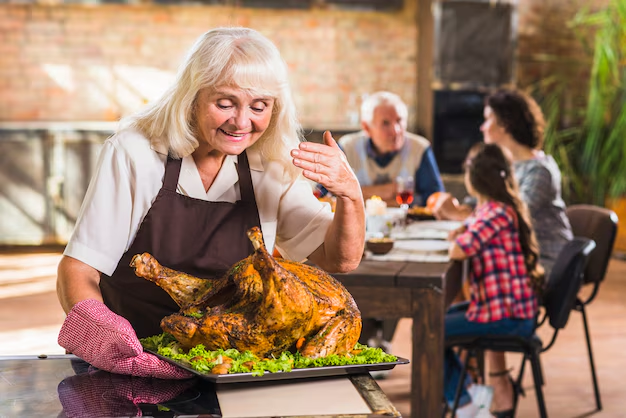How Long Can You Safely Keep a Turkey in the Refrigerator?
When it comes to storing food, a common question during festive seasons or big gatherings is, "How long can a turkey be in the refrigerator?" Proper storage is key to maintaining the quality and safety of your poultry, ensuring that holiday feasts are memorable for the right reasons. Let's dive in to uncover the facts, tips, and best practices you need to keep your turkey fresh and delicious.
🦃 Understanding Turkey Shelf Life
The Basics of Refrigerated Turkey Storage
Refrigerating turkey, whether it's whole, cooked, or leftovers, requires attention to key details to maintain freshness and avoid spoilage. The USDA recommends keeping raw turkey in the refrigerator for no more than 1 to 2 days. However, cooked turkey or leftovers can be refrigerated for up to 3 to 4 days.
Factors Affecting Turkey's Shelf Life
Several factors influence how long turkey can remain safe to eat in the refrigerator, including:
- Temperature Consistency: Ensure your refrigerator maintains a temperature below 40°F (4°C) to slow bacterial growth effectively.
- Packaging Integrity: Turkey should be stored in airtight packaging to prevent exposure to air and moisture, which can quicken spoilage.
- Freshness at Purchase: The turkey's quality at the time of purchase can affect how long it stays fresh, hence opting for fresh, high-quality poultry is important.
🥶 Best Practices for Storing Turkey
Raw Turkey
To maximize the longevity and quality of raw turkey, consider the following steps:
Keep it Wrapped: Leave the turkey in its original packaging until you're ready to cook it. Opening the packaging can expose it to bacteria and air.
Use Trays or Containers: Place the packaged turkey on a tray or in a container to catch any juices that may leak, preventing contamination of other foods.
Positioning in the Fridge: Store the turkey on the bottom shelf to avoid drips contaminating other foods.
Cooked Turkey
For cooked turkey, storage tips slightly vary:
Cool Quickly: After cooking, let the turkey sit until it cools to room temperature. Aim to refrigerate within two hours to minimize bacterial growth.
Slice and Store: Cut the turkey into portions for easier storage and quicker cooling.
Use Airtight Containers: Store sliced turkey in airtight containers or wrap tightly in aluminum foil.
📝 Quick Storage Tips for Turkey
- 📅 1-2 days for raw turkey
- 🕒 3-4 days for cooked or leftover turkey
- ✅ Store below 40°F (4°C)
- 🥣 Use airtight containers for cooked turkey
🥘 What to Do If Turkey Has Gone Bad?
Recognizing spoilage is crucial to ensuring food safety. Here are signs that your turkey has gone bad:
- Off Odor: A sour or unpleasant smell is a clear indicator of spoilage.
- Texture Changes: Slimy or sticky textures mean the turkey is no longer fit to consume.
- Color Changes: Discoloration, particularly in raw turkey, signals possible bacterial growth.
If you notice any of these signs, it's safer to dispose of the turkey rather than risk any potential health issues.
🕵️♂️ How to Extend Turkey's Shelf Life
If sticking to the given timeframes seems challenging, consider these alternatives to extend the turkey's shelf life:
Freezing Turkey
Freezing is an excellent way to store turkey for long-term use, maintaining quality and safety. Here's how:
Proper Portioning: Divide the turkey into meal-sized portions before freezing.
Use Freezer-Safe Bags: Wrap the portions in freezer paper or use zip-top freezer bags to lock out air.
Label Clearly: Always label with the date of freezing to keep track.
Thawing Frozen Turkey
When it's time to use your frozen turkey, here are safe thawing methods:
- Refrigerator Thawing: Plan for approximately 24 hours of thawing for every 4-5 pounds of turkey.
- Cold Water Thawing: For quicker thawing, immerse in cold water, changing the water every 30 minutes. Approximate time is 30 minutes per pound.
🍽️ Tasty Ways to Use Leftover Turkey
Transform leftovers into tempting dishes to avoid wastage and enjoy turkey in diverse forms:
Turkey Soup
Use turkey bones and meat to whip up a hearty soup with vegetables and broth.
Turkey Sandwiches
Create classic sandwiches layered with cheese, pickles, and a spread of your choice.
Turkey Pot Pie
Combine turkey chunks with vegetables and creamy sauce, then bake under a crust for a comforting pot pie.
🌟 Creative Ideas For Using Leftovers
- 🥪 Sandwich Delight: Swap regular fillings for turkey.
- 🍲 Hearty Soup: Perfect for cold days.
- 🥧 Savory Pot Pies: A feast in itself.
👩🍳 Practical Kitchen Hygiene Tips
Alongside storage and consumption, maintaining hygiene is paramount:
- Wash Hands: Regularly wash hands with soap before and after handling turkey.
- Clean Surfaces: Disinfect countertops and utensils that come into contact with raw turkey.
- Separate Raw and Cooked Foods: Avoid cross-contamination by using different cutting boards.
Appreciating the nuances of food storage, particularly for large items like turkey, is essential for delightful and worry-free meals. By following these guidelines, you're well-equipped to keep your turkey fresh, safe, and ready to complement any feast. Remember, in the kitchen, diligence in storage often spells the difference between a meal that's memorable for its flavors and one recalled for less pleasant reasons. Stay informed, store wisely, and enjoy your turkey with peace of mind!
